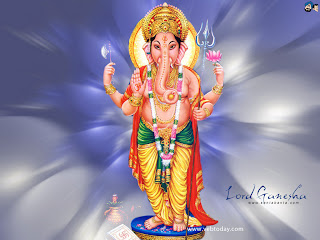Ganesha also spelled Ganesa or Ganesh, also known as Ganapati , Vinayaka is one of the deities best-known and most widely worshipped in the Hindu pantheon His image is found throughout India and Nepal.Hindu sects worship him regardless of affiliations. Devotion to Ganesha is widely diffused and extends to Jains, Buddhists, and beyond India. Although he is known by many other attributes, Ganesha's elephant head makes him particularly easy to identify. Ganesha is widely revered as the Remover of Obstacles and more generally as Lord of Beginnings and Lord of Obstacles Vighnesha , Vighneshvara patron of arts and sciences, and the deva of intellect and wisdom. He is honoured at the beginning of rituals and ceremonies and invoked as Patron of Letters during writing sessions.Several texts relate mythological anecdotes associated with his birth and exploits and explain his distinct iconography.Ganesha emerged a distinct deity in clearly recognizable form in the 4th and 5th centuries CE, during the Gupta Period, although he inherited traits from Vedic and per-Vedic precursors. His popularity rose quickly, and he was formally included among the five primary deities of Smartism (a Hindu denomination) in the 9th century. A sect of devotees called the Ganapatya , who identified Ganesha as the supreme deity, arose during this period The principal scriptures dedicated to Ganesha are the Ganesha Purana, the Mudgala Purana, and the Ganapati Atharvashirsa.
Although he is known by many other attributes, Ganesha's elephant head makes him particularly easy to identify. Ganesha is widely revered as the Remover of Obstacles and more generally as Lord of Beginnings and Lord of Obstacles Vighnesha , Vighneshvara patron of arts and sciences, and the deva of intellect and wisdom. He is honoured at the beginning of rituals and ceremonies and invoked as Patron of Letters during writing sessions.Several texts relate mythological anecdotes associated with his birth and exploits and explain his distinct iconography.Ganesha emerged a distinct deity in clearly recognizable form in the 4th and 5th centuries CE, during the Gupta Period, although he inherited traits from Vedic and per-Vedic precursors. His popularity rose quickly, and he was formally included among the five primary deities of Smartism (a Hindu denomination) in the 9th century. A sect of devotees called the Ganapatya , who identified Ganesha as the supreme deity, arose during this period The principal scriptures dedicated to Ganesha are the Ganesha Purana, the Mudgala Purana, and the Ganapati Atharvashirsa.Ganesh Chaturthi

Street festivities in Hyderabad,India
An annual festival honours Ganesha for ten days, starting on Ganesh Chaturthi, which typically falls in late August or early September.
The festival begins with people bringing in clay idols of Ganesha, symbolising Ganesha's visit. The festival culminates on the day of Ananta Chaturdashi, when idols (
murtis) of Ganesha are immersed in the most convenient body of water,
while the people shout "Ganapati Bappa Morya" (Ganesh come back soon next year).
Some families have a tradition of immersion on the 3rd, 5th, or 7th day. In 1893, Lokmanya Tilak transformed this annual Ganesha festival from private family celebrations into a grand public event.
He did so "to bridge the gap between the Brahmins and the non-Brahmins and find an appropriate context in which to build a new grassroots unity between them" in his nationalistic strivings against the British in Maharashtra.
Because of Ganesha's wide appeal as "the god for Everyman", Tilak chose him as a rallying point for Indian protest against British rule.
Tilak was the first to install large public images of Ganesha in pavilions, and he established the practice of submerging all the public images on the tenth day.
Today, Hindus across India celebrate the Ganapati festival with great fervour, though it is most popular in the state of Maharashtra.
The festival also assumes huge proportions in Mumbai, Pune, and in the surrounding belt of Ashtavinayaka temples.
 Although he is known by many other attributes, Ganesha's elephant head makes him particularly easy to identify. Ganesha is widely revered as the Remover of Obstacles and more generally as Lord of Beginnings and Lord of Obstacles Vighnesha , Vighneshvara patron of arts and sciences, and the deva of intellect and wisdom. He is honoured at the beginning of rituals and ceremonies and invoked as Patron of Letters during writing sessions.Several texts relate mythological anecdotes associated with his birth and exploits and explain his distinct iconography.
Although he is known by many other attributes, Ganesha's elephant head makes him particularly easy to identify. Ganesha is widely revered as the Remover of Obstacles and more generally as Lord of Beginnings and Lord of Obstacles Vighnesha , Vighneshvara patron of arts and sciences, and the deva of intellect and wisdom. He is honoured at the beginning of rituals and ceremonies and invoked as Patron of Letters during writing sessions.Several texts relate mythological anecdotes associated with his birth and exploits and explain his distinct iconography.











0 comments:
Post a Comment